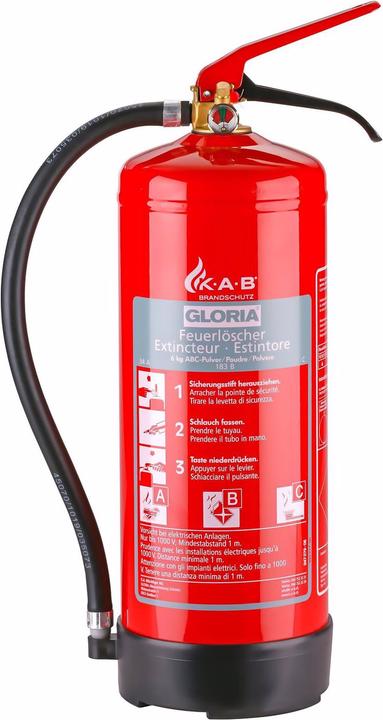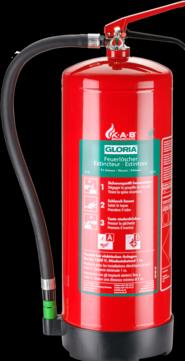
Too Many Fire Extinguishers? Here's How to Choose the Right One
Discover five essential tips to help you select the perfect fire extinguisher for your needs.
Last updated 1 day ago. Automatically generated content.


Select options and limit the number of products
The extinguishing agent type in a fire extinguisher determines its effectiveness against different classes of fires, such as those involving solids, liquids, or electrical equipment. Choosing the correct agent is crucial for ensuring safety and minimizing damage during a fire emergency.
Popular options (you can select more than one)
Powder fire extinguisher
Typical price
100.– to 100.–Contains a dry chemical powder that can extinguish Class A, B, and C fires.
Ideal for versatile fire protection in homes, vehicles, and industrial settings, providing a broad range of fire suppression.
Bestseller
Foam fire extinguisher
Typical price
38.– to 120.–Utilizes a foam solution to smother fires by forming a barrier between the fuel and the air.
Best suited for Class A and B fires, particularly effective for liquid fires, offering safe and efficient firefighting.
Bestseller
Fire class categorizes the type of fire a fire extinguisher is designed to combat, based on the materials involved. Understanding fire classes is crucial for selecting the appropriate extinguisher to effectively and safely address specific fire scenarios.
Popular options (you can select more than one)
A
Typical price
94.– to 100.–Suitable for fires involving ordinary combustibles such as wood, paper, and textiles.
Class A extinguishers are ideal for use in homes and offices where such materials are common.
Bestseller
B
Typical price
94.– to 100.–Designed to combat fires fueled by flammable liquids like gasoline, oil, and grease.
Class B extinguishers are essential in kitchens and garages, where these substances are frequently found.
Bestseller
C
Typical price
100.– to 100.–Intended for fires involving electrical equipment, such as appliances and wiring.
Class C extinguishers are crucial in environments with a lot of electrical devices, ensuring safety without the risk of conducting electricity.
Bestseller
Filling volume refers to the amount of extinguishing agent contained within a fire extinguisher, determining its capacity to put out fires. Selecting the appropriate volume is crucial for ensuring adequate fire protection based on the size and potential fire risks of the area.
Popular options
Up to 3 l
Typical price
33.– to 72.–Compact size makes it easy to handle and store in small spaces.
Ideal for small kitchens, vehicles, or personal use where minor fire risks are present.
Bestseller
3.1 - 6 l
Typical price
85.– to 290.–Offers a moderate amount of extinguishing agent for more substantial fire coverage.
Suitable for home and small office use, providing a balance between size and capacity.
Bestseller
6.1 - 9 l
Typical price
200.– to 360.–Larger capacity for handling more significant fire threats.
Recommended for larger spaces such as workshops, garages, or areas with higher fire risks.
Bestseller
The generation of pressure in fire extinguishers determines how the extinguishing agent is expelled. Understanding this factor helps in selecting a fire extinguisher that meets specific safety needs and ease of use requirements.
Popular options (you can select more than one)
Permanent pressure extinguishers
Typical price
68.– to 100.–Contain a constant pressure, making them ready for immediate use.
Suitable for environments where quick response is crucial, such as in homes or small offices.
Bestseller
Charge extinguishers
Typical price
61.– to 290.–Require activation to release pressure, typically via a separate gas cartridge.
Ideal for industrial settings where regular maintenance ensures readiness and reliability.
Bestseller

Mentrex Fire extinguishing spray 600 ml A, B, E, F
A, B, E, F
The fire class indicates the type of fire a fire extinguisher can effectively combat. Choosing the right class is crucial for safety, as using an incorrect extinguisher can be ineffective or even dangerous.
Popular options (you can select more than one)
A
Typical price
94.– to 100.–Designed for fires involving ordinary combustibles like wood, paper, and cloth.
Ideal for homes and offices where such materials are common, ensuring quick and effective response to typical fires.
Bestseller
B
Typical price
94.– to 100.–Suitable for fires involving flammable liquids like oil, gasoline, and grease.
Essential for kitchens, workshops, and garages to safely handle fire risks associated with liquid fuels.
Bestseller
C
Typical price
100.– to 100.–Intended for electrical fires involving energized electrical equipment.
Crucial for areas with electrical appliances, ensuring safety without the risk of electrical shock.
Bestseller
C
Typical price
100.– to 100.–Intended for electrical fires involving energized electrical equipment.
Crucial for areas with electrical appliances, ensuring safety without the risk of electrical shock.
Bestseller
